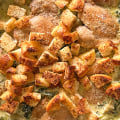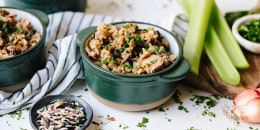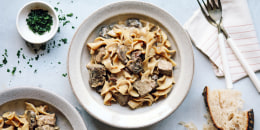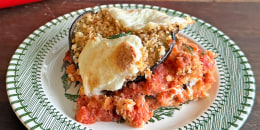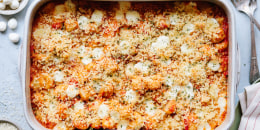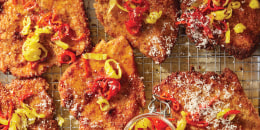Chef notes
The first meal my husband and I shared while honeymooning in Italy was a perfect plate of cheese ravioli in tomato sauce. Only a couple of hours earlier we'd touched down in Naples and drove to nearby Sorrento, where we unloaded our luggage under the speckled shadows of fragrant orange trees. Lunch was served overlooking the Bay of Naples, its glittering waves nodding toward the island of Capri, and at that moment, we couldn't have asked for anything more.
This recipe is pieced together from memory and taste. After falling down a deep internet rabbit hole, I discovered that the ravioli we enjoyed that afternoon was inspired by ravioli Capresi. Pasta parcels from Capri filled with caciotta, a local semi-soft cheese, its closest American relative is Monterey Jack, which I suggest here — although not quite the table cheese of Capri, it's a little something unexpected that makes this filling melt in your mouth. Ravioli Capresi are traditionally made with a soft wheat and water dough and served in a light tomato sauce with plenty of good extra-virgin olive oil.
Technique tip: Marjoram is an herb you'll come across often in Italian cooking. It's similar to oregano, aromatic with hints of citrus and pine, and, like oregano, a little can go a long way.
Ingredients
- 2¼ cups (350 grams) 00 or all-purpose flour, plus more for rolling
- 5 tablespoons (50 grams) semola rimacinata or semolina flour
- 4 large eggs plus 1 to 2 eggs yolks (225 grams), lightly beaten
- 8 ounces fresh mozzarella, cut in 1/2-inch cubes
- 5¼ ounces grated caciotta or Monterey Jack cheese
- 1½ ounces finely grated Parmigiano-Reggiano
- fresh marjoram leaves, to taste
- kosher salt and freshly ground black pepper
- 1 large egg and 1 large egg yolk, beaten together
- 2¼ pounds ripe tomatoes
- 4 cloves garlic, peeled and finely chopped
- 1½ loosely packed cups fresh basil leaves, roughly torn, plus more for serving
- kosher salt
- 1/3-1/2 cup high-quality extra-virgin olive oil, plus more for serving
- finely grated Parmigiano-Reggiano or Pecorino Romano, for serving (optional)
Preparation
For the standard egg pasta dough:
1.Combine the flours in a wide mixing or serving bowl. Keep the flour in the bowl (this prevents runaway liquids) or turn it out onto a work surface. Make a wide "well" in the center with your fist, forming a wall of flour tall enough on all sides to contain the eggs. Pour the eggs into the well.
2.Using a fork, gradually incorporate a portion of the flour, a couple of teaspoons or so at a time, from the inner rim of the well into the eggs in a circular motion (à la scrambled eggs) until a thick, custardy batter forms. You'll use only about a quarter of the flour at this point; the majority will remain loose.
3.Incorporate the remaining flour into the thickened eggs, either by folding and pressing the flour into the center with your hands until it becomes a shaggy ball or, if you're working on a flat surface, cutting the flour into the eggs with the help of a bench scraper. If it looks like a total mess — sticky here, flaky there — you're doing it right. If you've been using a bowl, transfer the mixture to a flat surface, along with any large flaky pieces. It's also totally normal to have some flour left behind.
4.Knead the dough vigorously however works best for you (don't be shy; you can't overwork it). I like to push it forward with the heel of my hand, then fold it over on itself about halfway. Do this a few times in one direction, then rotate the dough 90 degrees and repeat, shifting 90 degrees every few strokes. Once the dough starts to come together, brush away any remaining flaky pieces. Always give it time before adding flour or water — more often than not, it will sort itself out after a few minutes. Then, if the dough still feels dry, add a small amount of water with your fingers to the dry areas and knead until smooth, repeating as necessary; if it feels very soft and sticky, work in more flour until it firms up.
5.After about 5 minutes, cover the dough tightly and completely in plastic wrap or under an overturned bowl (you can also use a clean shower cap or snug air-tight container). Let it rest for 5 to 10 minutes — have a cup of coffee, a snack, a glass of wine — then uncover and knead the dough until it's smooth and firm, pliable but not soft, 3 to 5 minutes more. When it bounces back from a light touch to the surface, cover the dough tightly and completely once more. Let it rest at room temperature for at least 30 minutes and up to two hours.
For the cheese and herb filling:
1.Add the cheeses and a few marjoram leaves to the bowl of a food processor and pulse until well-combined. Season to taste with salt and pepper, adding more marjoram if you'd like.
2.Transfer to a mixing bowl and fold in the egg, egg yolk and another pinch of salt. (You can also finely chop the mozzarella and marjoram and mix everything together in a bowl.)
3.The texture of this filling is a little different than usual, almost dough-like — not to worry, the cheeses will melt together when cooked. Keep the filling in the bowl or transfer it to a piping bag; if chilling overnight, allow the filling to soften at room temperature for 30 minutes before use.
For the no-cook tomato and basil sauce:
If using large tomatoes, bring a pot of water to a boil and fill a large bowl with ice water. With a paring knife, score the bottoms of the tomatoes with a small X, just piercing the skin. Drop them into the water and cook until the skin near the X starts to loosen, about 2 minutes. Use a slotted spoon to transfer them to the ice bath. When the tomatoes are cool, peel away the skins. Remove the pulp and seeds and roughly chop the flesh. If you're using small tomatoes, halve or quarter them.
Combine the tomatoes, garlic and basil in a large serving bowl. Season generously with salt, then drizzle in the oil. Stir to combine. Leave the sauce to sit, covered, for at least 1 hour, ideally in a warm, sunny place.
To assemble:
1.Dust a sheet pan with semolina or line it with a dishcloth. Gather your tools and set up your pasta machine.
2.Cut off a quarter of the dough and keep the rest covered. Keep extra 00 or all-purpose flour nearby.
3.Set your pasta machine to its widest setting. For a Marcato Atlas 150, that's setting 0; for most KitchenAid attachments, that's setting 1.
4.Flatten the dough with your palm into a rough oval — smush it between your fingers if you need to or use a rolling pin to roll it into an oval that's about 1/4-inch (6-millimeters) thick. Position one of the dough's tapered ends in the center of your pasta machine and roll it through once. (If you're using the KitchenAid attachment, don't run the motor too fast; I usually prefer speed 2.) You should now have a longer oval-ish shape.
5.Rotate the dough 90 degrees, so the tapered ends run horizontally. Fold the ends toward the center like an envelope so that the width of the dough is similar to the width of the machine's rollers (about 6 inches/15 centimeters; hold it up to the machine to check). The ends might overlap in the center, or there might be a wide gap between them — it doesn't matter.
6.Flatten the dough again and, with the folded ends on either side, roll it through the widest setting once more.
7.Continue rolling the pasta through the machine in the same orientation, once on each progressive setting, until you reach the thickness of the pasta you're making (see below). Feed the dough straight down into the roller instead of letting it hang off the back of the machine, so it doesn't pull or tear.
8.If the dough is sticky or the surface starts to tear — this happens often with a KitchenAid, especially after setting 5 — dust both sides with 00 or all-purpose flour, spreading it around evenly and removing any excess.
9.Roll a quarter of your pasta dough into a sheet following the directions above, stopping at twice through setting 6 for a Marcato or setting 7 for a KitchenAid machine.
10.Lay the pasta sheet horizontally on your work surface — if you're using a countertop, dust it with some 00 or all-purpose flour first — and trim any uneven edges. Save the scraps for soups or a snack, or ball them up and cover them so they can be reused at the end.
11.Fold the pasta sheet in half crosswise, like a book, and make a crease to mark the midpoint. Unfold it and cut along the crease so you have two even pieces. Set one aside and cover it with a damp dishcloth or plastic wrap.
12.Gently press a round cookie cutter — I usually use a 2-inch (5-centimeters) or 2½-inch (6-centimeters) size — across the uncovered pasta sheet, just enough to see the circles' outlines but not enough to cut through. Fit as many outlines as possible while leaving a finger's worth of space between them and the edges of the sheet.
13.Spoon or pipe a dollop of filling in the center of each outline. Add enough to fill the round while leaving 1/4 inch (6 millimeters) of space between the dollop and the outline.
14.If the dough feels dry, dip a finger in a small amount of water and trace around the dollops of filling, or lightly mist the dough with a spray bottle. Uncover the other pasta sheet and carefully lay it on top of the filling (if there's flour on it, make sure that side is facing up), aligning the two sheets at one edge and draping it over. It's okay if the top layer doesn't look like it'll quite cover everything — you can stretch the dough if needed.
15.Trace and press your index fingers around each filling pocket to remove the air, lifting the top layer of pasta as needed and pushing the air out toward the nearest edge. Once the mounds of filling are sealed, lift the pasta up to make sure it's not sticking to your work surface.
16.To make the ravioli look more uniform, gently press the rim of a small glass or the blunt side of a smaller cookie cutter around each filling pocket. They'll puff up as the filling concentrates; it's incredibly satisfying but totally optional.
17.Cut out the ravioli with the cookie cutter, twisting it as you do so, then pinch around the edges of each piece to seal and thin out the dough. If the scraps are filling-free and feel pliable and hydrated, ball them up and cover them again. If they're dry or covered in filling, wipe away the filling and cut them into pieces to save for a snack or soups.
18.Arrange the finished ravioli in a single layer on the prepared sheet pan. Repeat with the remaining dough and filling.
19.Cook the ravioli in salted, gently boiling water until tender, about 2½ to 3 minutes, depending on freshness.
To serve:
Add the pasta to the sauce and stir to combine. Finish with another drizzle of oil, more basil and a shower of cheese, if you'd like.
Adapted from "PASTA EVERY DAY" by Meryl Feinstein. Copyright © 2023 by Meryl Feinstein. Photographs by Nico Schino. Used with permission of Voracious, an imprint Little, Brown and Company, New York. All rights reserved.



